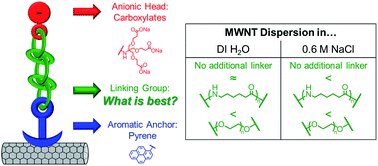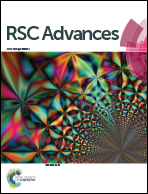Key role of the linker in pyrene-linker-carboxylate surfactants for the efficient aqueous dispersion of multiwalled carbon nanotubes†
Abstract
This study establishes that the structure of the linker group between the hydrophobic and hydrophilic units in the new surfactants 1–13 plays an important role in the dispersibility of multiwalled carbon nanotubes (MWNTs) in water. The systematic variation of the linker group in amphiphilic surfactants for carbon nanotubes has not been previously investigated. In the present series, the hydrophobic unit is derived from pyrene, the hydrophilic unit comprises 1–9 carboxylate groups and the linker is based on amide or ether moieties. The resulting MWNT–surfactant dispersions, up to concentrations and efficiencies of ca. 160 mg L−1 and almost 50%, respectively, have been characterised by UV-vis absorption spectroscopy studies which provide detailed structure–property relationships, while transmission electron microscopy (TEM) was used to confirm that the MWNTs were well dispersed. For many of the new surfactants enhanced dispersion efficiency is observed compared to commercial surfactants. The efficiency of the dispersion is affected by the presence, functionality and particularly the length of the linker, and also the number of terminal carboxylate units. The marked effect of sodium, potassium and calcium cations on the dispersion behaviour is explained by interactions between the metal ions and the surfactant and an ionic screening mechanism. We also demonstrate that the dispersibility of the MWNT–surfactant dispersions can be reversibly switched ‘off’ and ‘on’ by addition of acid and base, respectively. The experimental results are supported by theoretical calculations of solvation energy ΔES. This study represents a significant advance in the design of multi-functional surfactants for efficient aqueous dispersions of carbon-based materials.



 Please wait while we load your content...
Please wait while we load your content...